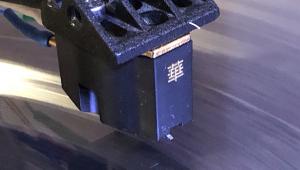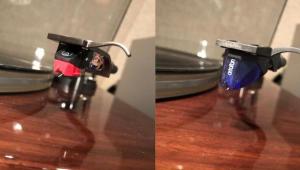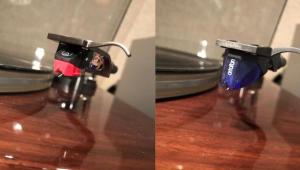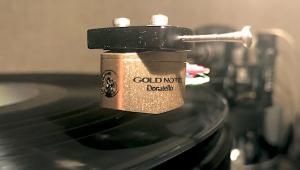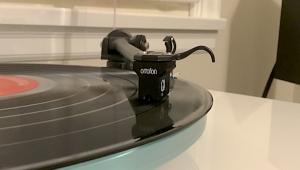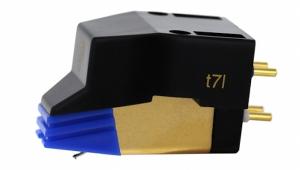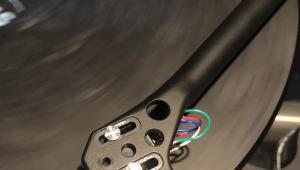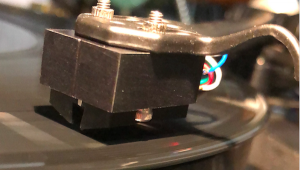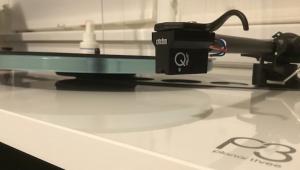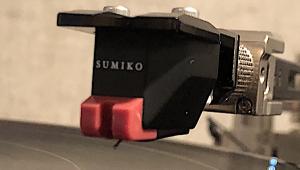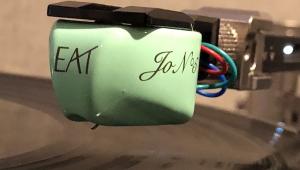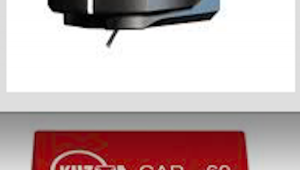The Hana SL MC ($750) Versus The Ortofon Quintet Black S MC ($999)
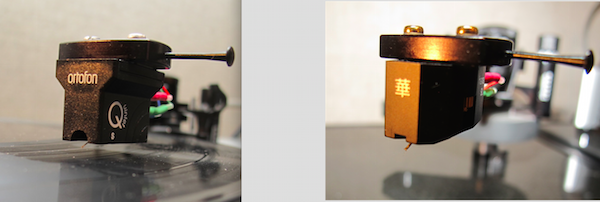
Let's start with the less expensive ($750) Hana SL manufactured by Excel Sound Corporation. The video I shot there is still running on our "player" at the top right but even when it's been replaced, you can still watch it on the analogPlanet.com YouTube channel.
The Hana SL is a low output (.5mV/1kHz) moving coil cartridge—the most expensive of 4 in the Hana line. Yes you pay more and get less output! That is the way of the audiophile world, though it's also true of food: you pay more for salt and sugar free. So they take stuff out and you pay more. But I digress.
The Hana features a nude Shibata stylus fitted to an aluminum cantilever. Output balance is spec'd at < 1.5dB/1kHz, recommended VTF (vertical tracking force) is 2 grams, trackability is 70µm/2gr, channel separation is rated at 28dB/1kHz while frequency response is rated at 15Hz-32kHz. The internal impedance is rated at 30ohms/1kHz with suggested loading impedance of >400 ohms. The cartridge is on the light side at 5 grams.
Setting up the Hana SL was relatively easy, though because the body isn't tapped, nuts are required to secure it to the head shell. This is made somewhat easier than usual using the stylus guard as a "platform" for the nuts. I found close to accurate both the separation and channel balance specs (measured 25dB separation, with 1.5dB balance), with the azimuth angle just slightly askew from cantilever perpendicularity. 92 degree SRA, which is critical for the shibata stylus profile was achieved with the arm very close to parallel to the record surface. In other words, the build quality of this relatively inexpensive cartridge was as close to ideal as is humanly possible. The cartridge sailed through the Ortofon test record's trackability bands.
The Hana SL was installed on the Graham Phantom III—a $7000 tone arm mounted on the $29,500 Air Force III turntable connected to the CH Precision P1 phono preamplifier augmented with the outboard X1 power supply, the combination of which costs more than $45,000. In other words the budget cartridge got to ride in the First Class section.
Two of the P1's 3 inputs are current amplification based and so don't require any loading. However, as I reported in the phono stage "shoot out", I did run the Hana into the P1's voltage gain MC stage to find the ideal load for use with the more traditional phono preamps used there. That was accomplished using the P1's test record and "set up wizard" that produces a series of frequency response curves that you can switch among to find the flattest response—in other words the load that best tamps down the typical MC high frequency response peak.
The measured response differences between 100 ohms and 400 ohms was not significant but what was consistent throughout was a slight recess in frequency response in the upper midrange over a wide expanse of frequencies. And that is clearly audible. It’s what gives the SL such a pleasingly relaxed yet detailed sonic signature.
While the Japanese character silk screened on the front of the body means “brilliant and gorgeous” I’d say the Hana’s sonic personality is more “gorgeous” than it is “brilliant”—and I think that’s what most buyers like about it, especially if they are using it in a system featuring less costly electronics that might impart their own “brilliance”.
Moving coil cartridges have a reputation for somewhat bright and even aggressive but that’s hardly the Hana SL’s personality. Instead it’s smooth, somewhat laid back and sweet, yet very well detailed thanks in part to the shibata stylus profile, which when viewed from the side (with a very powerful microscope!) presents a tall, very narrow ridge that can reach into the most severely and tightly cut horizontal groove modulations while tracing with equal accuracy the vertically inscribed modulations.
Imagine a round stylus traveling up a vertical groove modulation (think of a hill). It rides up on one side of the round stylus, and at the top of the “hill” it transfers the contact to the other side of the round stylus, with a relatively lengthy “handoff” time. The severely narrow Shibata stylus profile means that the “handoff” is almost instantaneous, which results in far greater detail retrieval and a sense of “speed”—for good reason.
The relatively high internal impedance for a .5mV output cartridge is usually the result of many turns of wire on the cross-shaped armature, which may be required because of the use of less than the most powerful magnets, probably to keep the cost down so such a high performance cartridge can be sold for such a reasonable price.
The good channel separation and channel balance, not surprisingly, produces a generously wide soundstage, with excellent image solidity, stability and three-dimensionality. The added coil mass counters somewhat the shibata’s detail retrieval by slowing down the system, so that while the Hana SL’s retrieval of detail is good, when you spend more to get more powerful magnets and fewer wire turns (and lower mass), there’s more detail to be had.
However given the Hana SL’s price and its outstanding build quality, the cartridge sets a very high performance bar! The Hana SL is sufficiently fast and precise to produce very fine transient performance without “etch” or “grain”, on cymbals for instance, yet its generally warm and slightly mellow personality make it great for female vocals and massed strings.
Bass performance was good, particularly in terms of extension, though transients were somewhat slow, producing a more mellow and somewhat soft but still very pleasing sound rather than the full bore bass transient ferocity a Jaco Pastorious fan might be craving. Dynamic performance was very good, especially for the money but not the last word in terms of “slam”, which shouldn’t be surprising given the plastic body and the cost.
In other words, the Hana SL is a “cartridge for all seasons” that combines good retrieval of detail with a pleasing overall warmth that works well with all musical genres. No wonder it’s become such a popular “crowd pleaser” over the past few years.
An additional $250 gets you the Ortofon Quintet MC Black “S”. The “S” refers to its sapphire cantilever, which is fitted with a nude shibata stylus. Sapphire cantilevers became popular during the “great boron cantilever shortage” of a few years ago. Like boron, sapphire is both ultra-stiff and relatively light. Lower mass produces faster response times.
The Quintet Black “S” is the top of Ortofon’s lower cost Quintet moving coil line. The specs include an output of 0.3mV, < 1.0dB channel balance and > 23dB separation. Frequency response is rated at 20-20kHz ±1.5dB with 80µm “trackability” at the recommended 2.3 gram VTF. The internal impedance is spec’d at 5 ohms, while recommended loading is > 20 ohms. The Quintet Black “S” weighs 9 grams. Compliance is typically low (for a MC cartridge) at 15µm/mN.
Set up was made somewhat easier than the Hana’s thanks to tapped and threaded mounting holes. Otherwise set up went equally smoothly with 92 degree SRA achieved with the body tipped slightly down from parallel to the record surface. With the cantilever perpendicular to the record surface separation measured 25dB with balance within an excellent 1dB. This indicates excellent build quality, which for Ortofon is not surprising.
Ortofon warns against using solvent-based stylus cleaners that can dissolve the cement used to attach styli to cantilevers throughout much if not all of the company’s cartridge lines.
The low internal impedance usually means fewer coil turns, which also means “faster” and more responsive performance at the cost of lower output, in this case, .3mV versus the Hana’s more generous .5mV. This is a big output difference meaning for best low noise, wide dynamic performance the Ortofon should be used only with a high gain (circa 60-65dB) low noise phono preamp.
The sound produced by the Ortofon Quintet Black “S” was definitely faster, leaner and more detailed than that of the Hana SL. Transients were sharper, particularly on bottom and top end extension was noticeably airier and somewhat brighter—perhaps too much so for some listeners’ sensibilities though it’s all dependent upon the rest of the system.
The Black’s frequency response was observationally flatter particularly in the mids and upper mids where the Hana was somewhat recessed. This produced a more “in your face” kind of sound that many crave though many do not!
Again the imaging and soundstaging were very good as the measurements would lead you to expect, though arguably the Hana’s had somewhat more body at the expense of image precision and “edge definition”. Bass was faster and “tighter”, perhaps even a bit leaner but definitely more precisely drawn: more “pluck” and “bite” and a little less of the harmonic structure that the Hana so generously provides, though to some degree that’s probably a slight but pleasing coloration.
So yes, your $250 additional dollars (which is a great deal of money for many) does get you a tauter, somewhat higher performance sonic “ride” that’s faster with more precisely drawn transients at both frequency extremes, greater dynamic “slam” and a somewhat more linear overall balance that’s more “sports car” to the Hana’s “family sedan”. Depending upon “road conditions” you might prefer the “family sedan” ride to the “sports car”!
. A few Ortofon enthusiasts claim that running the cartridge “nude” by removing the body improves further the cartridges “speed” and bass performance, but my policy is to review as supplied and not as modified.
Conclusion
Spending a few weeks listening (on and off) to both of these moderately priced cartridges (“moderate” in terms of what the top of the market looks like price-wise) proves a few things: first of all, that it’s possible to provide high build quality at reasonable prices (I’ve gotten some poorly built very expensive cartridges over the years), secondly that without breaking the bank or dissolving a marriage you can get sonic performance that handily beats CD in all respects other than measured dynamic range. I’d rather listen long term to either of these cartridges than any digital system. You may draw other conclusions.
For long term listenability with the widest varieties of music and especially with recordings that vary from truly shitty and bright to the best in your collection, the Hana SL would be a great choice. It also may be the one to get if your system is sounding a bit edgy, bright and harsh with your current cartridge and you want to mellow it out a bit without losing detail resolution (in fact depending upon what you’re now using the shibata stylus might give you more resolution and a somewhat mellower sound.
If you want to max out the sound of the best recordings in your collection while paying a bit of a price when playing the worst, and if you can justify spending another $250, consider the Ortofon Quintet Black “S”.
In either case though, the shibata stylus demands precise set-up in every parameter so proceed with caution if your arm doesn’t allow you to adjust VTA/SRA! That said, if you own a Rega arm, you can increase SRA using spacers (Acoustic Signature makes really convenient ones for Rega 3 point mount arms that don’t require you to remove the arm from the plinth) and you can lower SRA by adding a thicker mat.
Which Do You Prefer?
Please stream these two 96/24 files of the same recording: the fabulous Cecíle McLorin Salvant singing with her trio “Never Will I Marry” from the “must have” 3 LP set Dreams and Daggers (Mack Avenue MAC 1120LP) mostly recorded live at The Village Vanguard. Not saying which cartridge is which here. If I’ve done my job (and you’ve done yours) you will know!



